Part 2: Dances of Western Europe and its Colonies
7 Colonial Dances of South America
1. The Colonization of South America
In the last chapter, we looked at the colonized countries of the Caribbean, Central America and Mexico. We now turn to the dance traditions from colonized South America. Because they were colonized by the same imperial powers, we of course find many similarities between these countries and the ones discussed in chapter 6, but of course there are important differences too.
While the French, Dutch and British had very small colonies in Guiana, Suriname and Guyana respectively, the vast majority of South America was conquered by the Portuguese and Spanish empires. As in the rest of the Americas, these invaders brought devastation to the indigenous populations including very sophisticated civilizations like the Incas. Today the cultures are blends of the indigenous people, Europeans and the African slaves they brought with them.
In this chapter, we first discuss Brazil, the largest country in South American, which was originally colonized by the Portuguese, and then we will discuss Spanish-speaking South America, looking at the diverse dance cultures that have emerged in those nations.
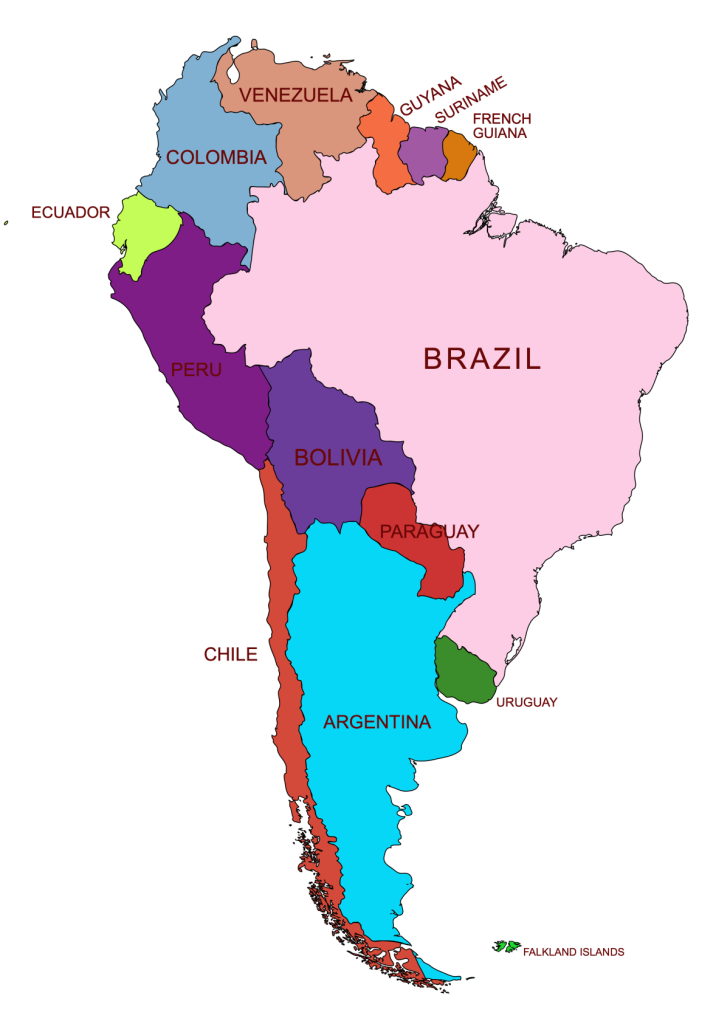
2. Brazil
2.1. Geography and History
Brazil is the largest country in South America, covering over 8.5 million square kilometers (3.2 million square miles), making up about half of South America’s landmass. It is also the largest Portuguese-speaking region in the world with about 215 million speakers (compared to Portugal’s 10 million).
With the exception of Chile and Ecuador, Brazil borders every South American. Brazil boasts a long coastline stretching over 7,400 kilometers (4,600 miles) along the Atlantic Ocean. The country has a number of distinct ecological regions. The Amazon rainforest covers a significant portion of Brazil’s territory, primarily in the north. This region is known for its dense tropical rainforests, diverse wildlife, and extensive river systems, including the Amazon River, the world’s largest river by discharge volume. The Brazilian Highlands dominate the central and eastern parts of Brazil. This region features plateaus, mountains, and savannas, including the Serra do Mar and the Serra da Mantiqueira Mountain ranges. Brazil has extensive coastal plains along its Atlantic coastline, including the Northeastern Coastal Plain, Southeastern Coastal Plain, and Southern Coastal Plain. These areas are home to major cities, ports, and agricultural regions. Brazil is one of the most biodiverse countries in the world, with vast tropical rainforests, savannas, wetlands, and coastal ecosystems. It is home to a large number of plant and animal species. Coffee became a major export crop, driving Brazil’s economy and shaping its society. The coffee boom led to the growth of cities such as São Paulo and Rio de Janeiro megacities. Brazil’s Amazon rainforest is under threat from deforestation, logging, mining, and agricultural expansion. Environmental protection and sustainable development are key concerns. The country is also rich in minerals, including iron ore, bauxite, gold, manganese, and nickel. The country is a major producer and exporter of minerals, supporting its economy.
Before the European conquest, Brazil was inhabited by numerous indigenous groups, including the Tupi, Guarani, and Gê peoples. In 1500, Portuguese explorer Pedro Álvares Cabral claimed Brazil for Portugal. The Portuguese established sugar plantations and began exploiting indigenous labor. The Portuguese also introduced African slaves to work on sugar plantations. Spain and Portugal signed the Treaty of Tordesillas in 1494, establishing Portugal’s claim to Brazil. In the 18th century, Brazil experienced a gold rush in the region known as Minas Gerais, leading to economic growth and increased immigration. Dom Pedro I, the son of the Portuguese king, declared Brazil’s independence from Portugal on September 7, 1822, leading to the formation of the Empire of Brazil. Brazil eventually became a constitutional monarchy. The empire lasted until 1889, when it was replaced by a republic. Brazil abolished slavery in 1888 — the last country in the Americas to do so. The abolition led to significant social and economic changes. Brazil experienced periods of military rule during the 20th century, including an authoritarian dictatorship from 1964 to 1985. This period was marked by political repression, censorship, and human rights abuses. Brazil transitioned to democracy in the mid-1980s, with the end of military rule. Since then, Brazil has held regular elections and experienced periods of economic growth and social change. Brazil faces significant social inequality, with disparities in income, education, and healthcare. Poverty, crime, and urban violence are persistent challenges. The country has experienced political instability and corruption scandals in recent years, leading to public distrust in government institutions and political polarization.
2.2. Brazilian Folk Costumes
In the southern region, the people wear traditional gaucho-inspired outfits, influenced by the region’s cowboy and ranching culture. This attire typically includes wide-brimmed hats, ponchos or shawls, long skirts or dresses, and leather boots, for the women. Men often wear bombachas, loose-fitting trousers gathered at the ankles, paired with leather boots and belts. They may also wear ponchos, chamarras (leather jackets), and wide-brimmed hats.
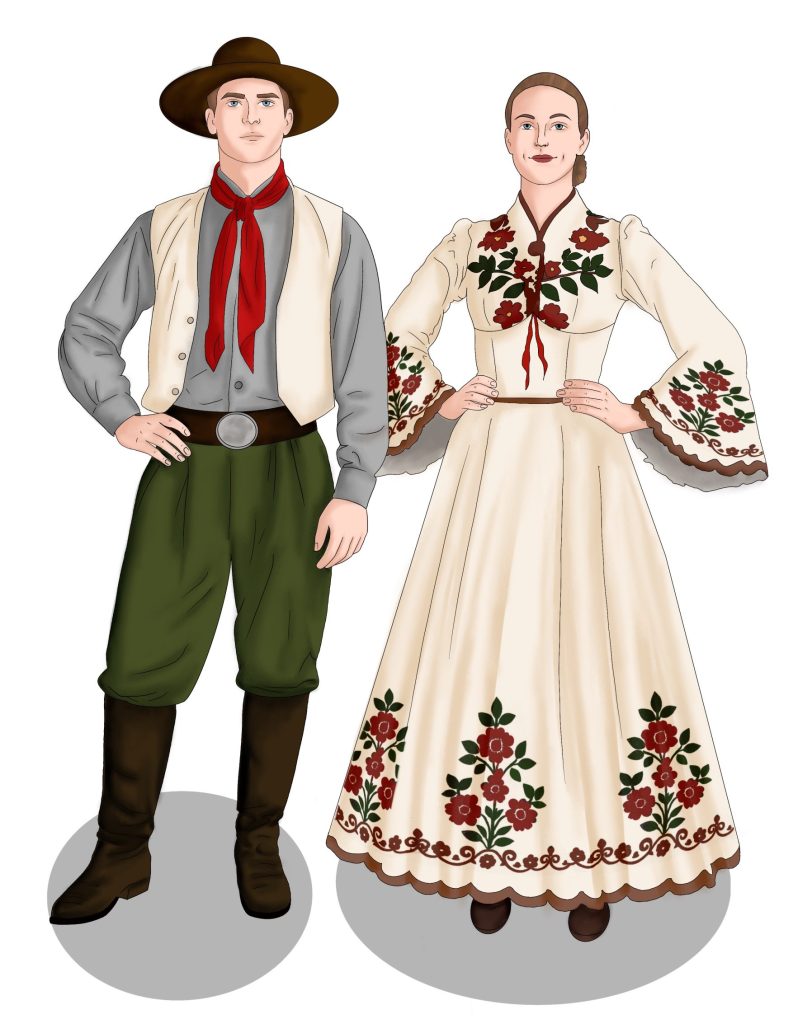
The Afro-Brazilian women of Bahia, wear an interesting costume called the Baiana de Acarajé costume. It shows a blend of African and older European styles with white multi layered skirts and petticoats, turbans, large jewelry and accessories. It is reminiscent of styles found in the Kwadril dresses of the Caribbean.
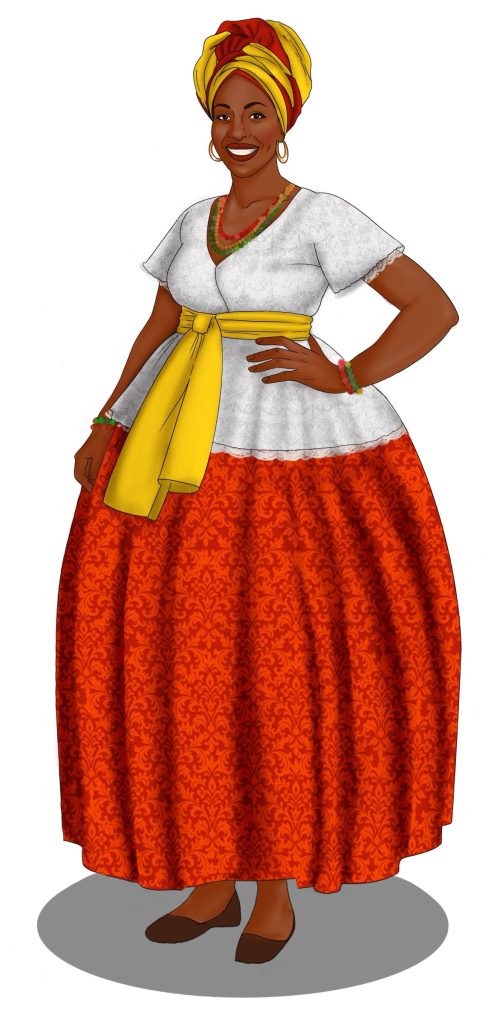
There are many other regional styles of dress in Brazil including traditional indigenous clothing in the Amazon region.
2.3. Brazilian Music
As in the rest of South and Central America, folk music in Brazil makes extensive use of various kinds of guitar including the six stringed violãoand the small four stringed ukulele-like cavaquinho. Also very common is the sanfona accordion.
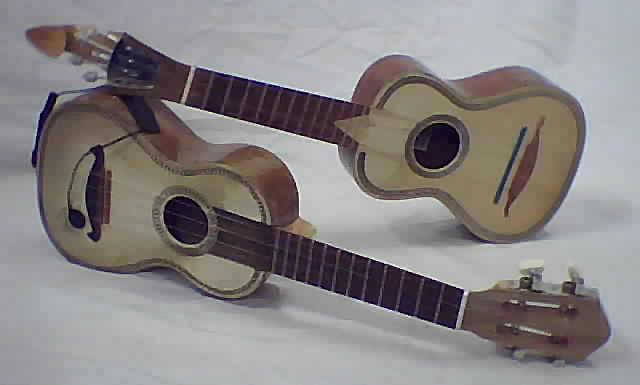
Brazilian music features very strong percussion. Percussion instruments include the cuica, the zabumba and the Brazilian version of the djembe drum.
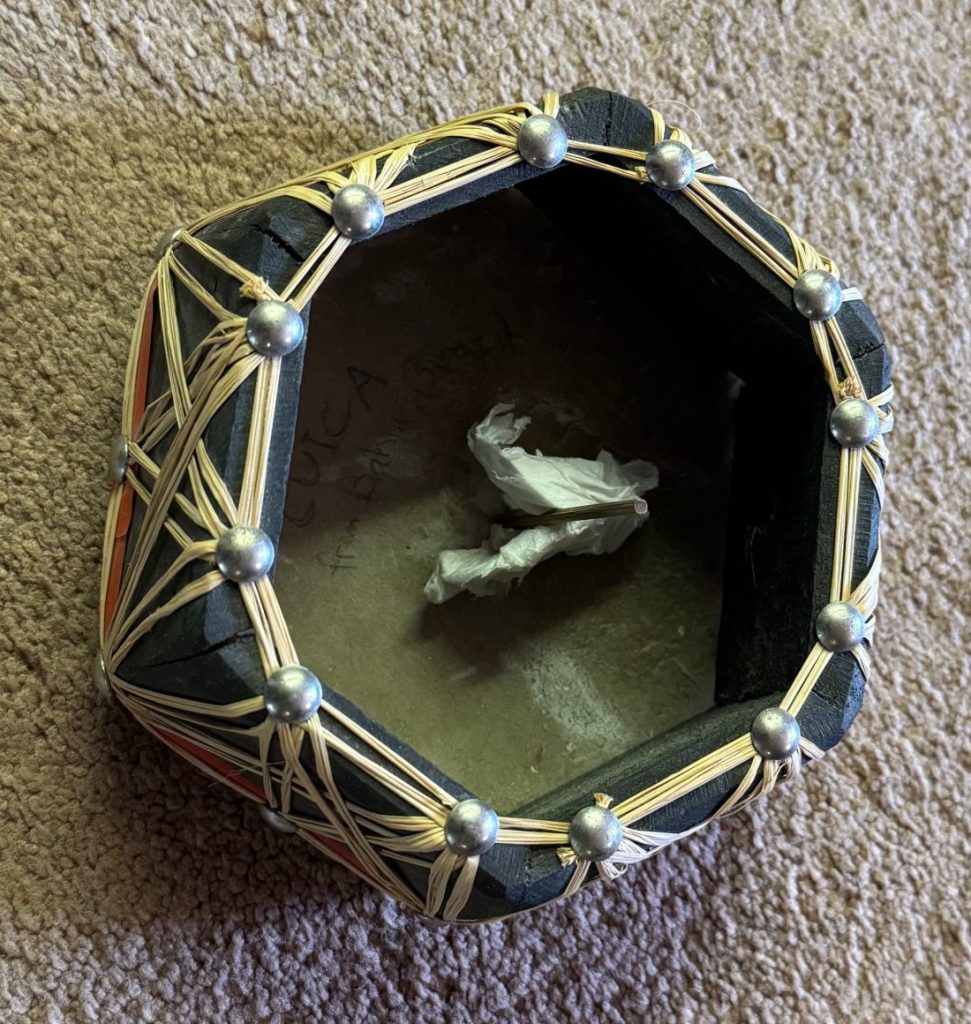
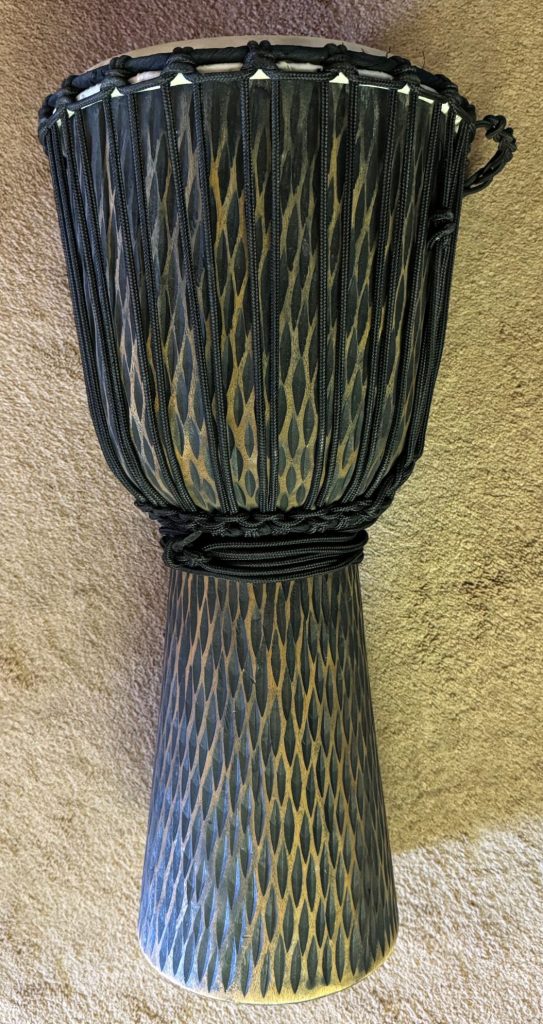
- Cavaquinho: https://youtu.be/cILU9TpQwxA?si=KJBjuTxgFbIpxTQW
- Sanfona: https://youtu.be/_NihKL_h0so?si=zGJYnNMOxxNBHhGu
- Violão: https://youtu.be/adzvsl20cSQ?si=mOhLoEomtAK6v_Qd
- Cuica: https://youtu.be/NVOtE1qSymU?si=ZRMBPk5VNn4aglo7
- Zambumba: https://youtu.be/lL2I5IAoaUc?si=sq4WMboCGruoZb-6
- Choro Music: https://youtu.be/KNkDx9rN4wU?si=oYWcxXpD9Oyvgq_r
- Samba Music: https://youtu.be/JvXbVEQNV6g?si=wvKiK0LyViN3u4CC
- Bossa Nova: https://youtu.be/oE8rYqP1Ejg?si=OJOAoHWwJjage24a
- Afro-Brazilian percussion: https://youtu.be/2cjJz2EEZdM?si=ZL0H8gozMxqBnrHP
2.4. Samba
Samba is Brazil’s most iconic dance, characterized by its infectious rhythm, lively movements, and energetic footwork. It originated in Afro-Brazilian communities in Rio de Janeiro in the late 19th century and has since become a symbol of Brazilian identity. Samba is often performed during Carnival celebrations, but it is also danced in social gatherings, clubs, and festivals throughout the year.
The roots of Samba can be traced back to the African slave populations brought to Brazil. These enslaved Africans brought with them their music, dance, and cultural traditions, which would later influence the development of samba. African religious and ceremonial practices, such as Candomblé and Batuque also played a significant role in shaping the rhythmic patterns, movements, and spiritual elements of early samba music and dance. As Brazil underwent rapid urbanization and industrialization, diverse cultural influences converged in the cosmopolitan cities, giving rise to new forms of music and dance. Samba found fertile ground in the marginalized communities of Rio de Janeiro, such as the favelas (urban slums), where it became a means of cultural expression and social cohesion. It also became closely associated with Carnival, Brazil’s annual festival of music, dance, and celebration. Today, the Samba folk tradition has also evolved into a highly stylized form of Latin ballroom dance with the same name. If you see Samba today, you’re likely to see the ballroom dance version.
- Ballroom style Samba: https://youtu.be/OaM8DALTFOY?si=K4gbts33QdKGIKzt
- Staged traditional Samba: https://youtu.be/UI-wGgjfgoU?si=OiFBgi0IlQANltEl
2.5. Capoeira
Capoeira is more than a dance, it is a martial art that unites elements of dance, acrobatics, and music. It originated among enslaved Africans in Brazil during the colonial period as a form of self-defense and resistance. Capoeira was often practiced clandestinely, disguised as a dance or ritual to evade detection by slave owners and colonial authorities. This allowed enslaved Africans to train and organize for resistance while appearing to engage in harmless recreational activities. Eventually, capoeira gained acceptance and recognition as a cultural practice and martial art. In 1937, it was legalized in Brazil, and efforts were made to institutionalize capoeira through the establishment of academies, associations, and cultural organizations. Capoeira began to attract international attention and spread beyond Brazil’s borders in the latter half of the 20th century. Today, capoeira is practiced worldwide, with millions of practitioners and a thriving global community. In 2014, UNESCO recognized capoeira as an Intangible Cultural Heritage of Humanity, acknowledging its significance as a cultural practice, art form, and symbol of resistance and resilience.
Capoeira practitioners, known as capoeiristas, engage in a dynamic and fluid exchange of kicks, sweeps, and flips accompanied by live music played on traditional instruments such as the berimbau, pandeiro, and atabaque. Capoeira is also recognized for its ritualistic elements, including the roda (circle) where the game takes place and the call-and-response songs sung in Portuguese.
Capoeira music is an essential component of the art form, providing rhythm, energy, and cultural context to the practice. Traditional capoeira music is performed live during capoeira gatherings and accompanies the movements of capoeiristas. The berimbau is the most iconic instrument in capoeira, often considered the soul of the roda. It consists of a single-stringed bow made of wood or metal, a gourd resonator, and a wooden stick or metal ring for striking the string.

Also accompanying capoeira are various percussion instruments. The pandeiro is a Brazilian tambourine with a circular frame and a single skin stretched over one side. It has metal jingles (platinelas) attached to the frame, which produce rhythmic accents when shaken or struck. The pandeiro provides the rhythmic foundation and embellishments in capoeira music. It is played by shaking, tapping, or striking the drumhead with the hand or fingers, adding dynamic percussion to the rhythm. The atabaque is a tall, conical drum with a single head, similar to a conga drum. It is traditionally made of wood and animal skin, stretched tightly over the drum’s body. The agogô is a double-bell percussion instrument originating from West Africa. It consists of two metal bells of different sizes attached to a handle or rod.
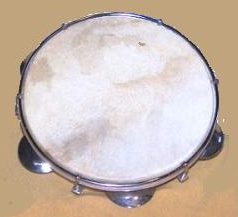
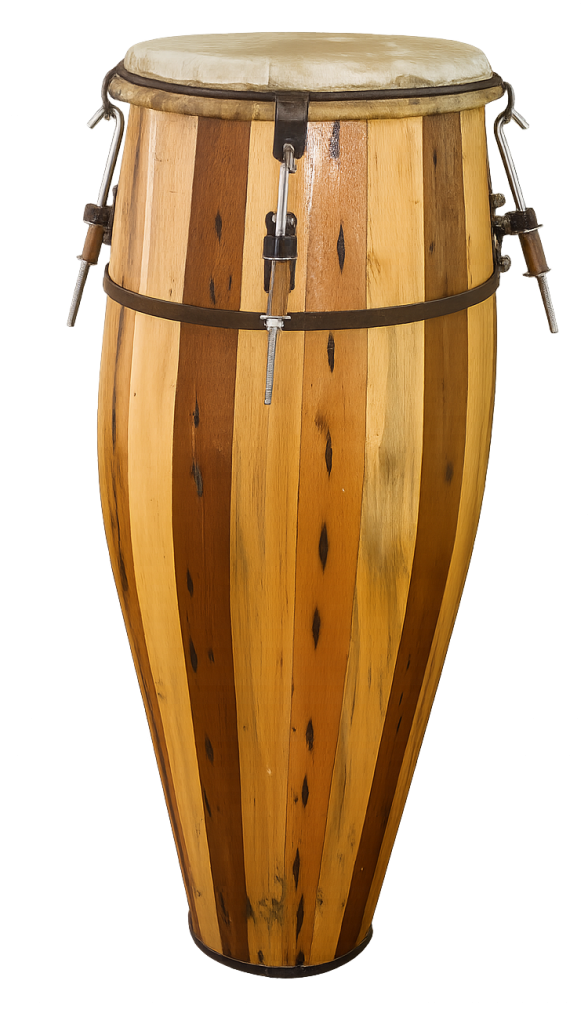
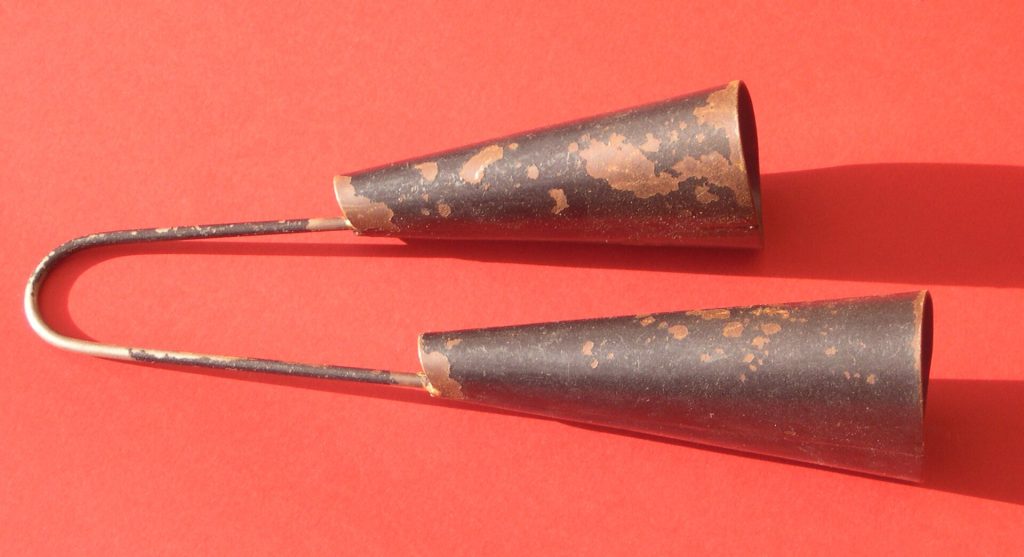
- Capoeira: https://youtu.be/Wz8b2xff7s0?si=YzCRKy-pDSyragY6
- Capoeira: https://youtu.be/G16xScfD5WM?si=006p_479IqdCfMBN
- Capoeira: https://youtu.be/dx-yJnJmnmo?si=lnx1PTrDg9uuhWZP
2.6. Other Brazilian Dance styles
Forró is a lively and romantic dance style originating from the Northeast region of Brazil, particularly in the states of Pernambuco, Ceará, and Bahia. It is characterized by its upbeat tempo, close partner dancing, and syncopated rhythms. Forró music features accordion, triangle, and zabumba and typically includes themes of love, longing, and rural life. Forró is danced in couples, with partners holding each other closely and moving in a circular or back-and-forth motion.
Frevo is a fast-paced and acrobatic dance style originating from the state of Pernambuco in Northeastern Brazil. It is characterized by its energetic footwork, high leaps, colorful costumes, and lively music. Frevo dancers, known as passistas, perform intricate steps and movements, often using small umbrellas as props. The dance is closely associated with Carnival celebrations in Recife and Olinda, where frevo parades and performances are a highlight of the festivities.
Maracatu is a traditional Afro-Brazilian dance and music style from the state of Pernambuco, particularly in the city of Recife. It is characterized by rhythmic drumming, vibrant costumes, and ceremonial processions. Maracatu combines African, indigenous, and European influences and is often performed during Carnival and other cultural events. There are two main styles of maracatu: maracatu nação (nation) and maracatu rural (rural), each with its own traditions, costumes, and musical arrangements.
- Forró: https://youtu.be/t7eej0eHuio?si=Nte6hdSIw0mrIMUq
- Forró: https://youtu.be/dXRrZsbH_84?si=p9IiZAwOgi8I-fve
- Frevo: https://youtu.be/Ub7gAqdhUWQ?si=eODt9rXicgK1EgWV
- Frevo: https://youtu.be/IS8r3wG8-Js?si=5qXmMk_h0E3csdZ-
- Maracatu: https://youtu.be/PSbJ1MTR8vw?si=LsZoFOPpkXzhx_Ns
- Maracatu: https://youtu.be/0Of1pKfcnjE?si=kC5ge6hIS3Xzt448
3. Spanish Speaking South America
Former Spanish colonies in South America include Argentina, Bolivia, Chile, Colombia, Ecuador, Paraguay, Peru, Uruguay, and Venezuela. These can roughly be divided into two groups with slightly different cultural characteristics: The Andean countries in the northwest and the countries in the southern cone.
Colonial powers implemented the encomienda system, which granted Spanish settlers control over indigenous labor and resources in exchange for Christianizing and “civilizing” indigenous peoples. This system led to the exploitation and mistreatment of indigenous populations. In many places they also brought with them enslaved Africans. The ravages of colonialism did not spare the indigenous peoples of South America. In some places, however, particularly in countries along the west coast of the continent indigenous peoples have won some greater political power in recent years. South America has experienced many political upheavals, military dictatorships, and civil conflicts throughout the 20th century. Cold War rivalries, social movements, and economic crises contributed to political instability and violence in many countries. Many South American countries have since transitioned to democratic governance, with regular elections and peaceful transfers of power. However, South America grapples with significant social inequalities, including disparities in income, education, healthcare, and access to basic services. Indigenous communities and marginalized populations often face discrimination and exclusion.
3.1. Traditional clothing.
Traditional Andean women’s clothing includes brightly colored skirts (called pollera), blouses, and shawls (manta), typically made from handwoven textiles using techniques passed down through generations. Women wear multiple layers of clothing for warmth, with intricately embroidered designs and patterns that reflect their indigenous heritage. Accessories such as colorful sashes, “bowler” hats adorned with pom-poms or tassels, and woven belts are also common. Andean men wear ponchos, wide-brimmed hats, and trousers made from wool or cotton fabrics. Ponchos are often intricately woven and serve as both a practical garment for warmth and a cultural symbol. Men also wear chullos, knitted caps with earflaps, and sandals made from leather or woven fibers.
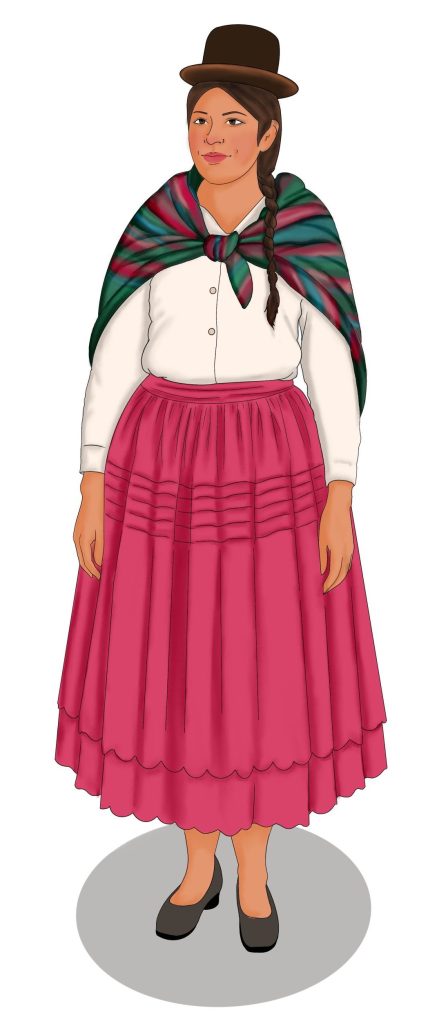
Traditional clothing in the Southern Cone region often includes long, flowing dresses or skirts made from lightweight fabrics such as cotton or silk. Women may wear blouses with intricate lace or embroidery, along with shawls or wraps for warmth. Accessories such as hats, scarves, and jewelry made from silver or semi-precious stones are also common. Men in the Southern Cone may wear ponchos, trousers, and shirts made from wool or linen fabrics. Ponchos are often woven with geometric patterns or symbols that reflect regional identities and cultural heritage. Men may also wear wide-brimmed hats, leather boots, often with spurs that make a clanging noise when dancing, and belts adorned with silver buckles.
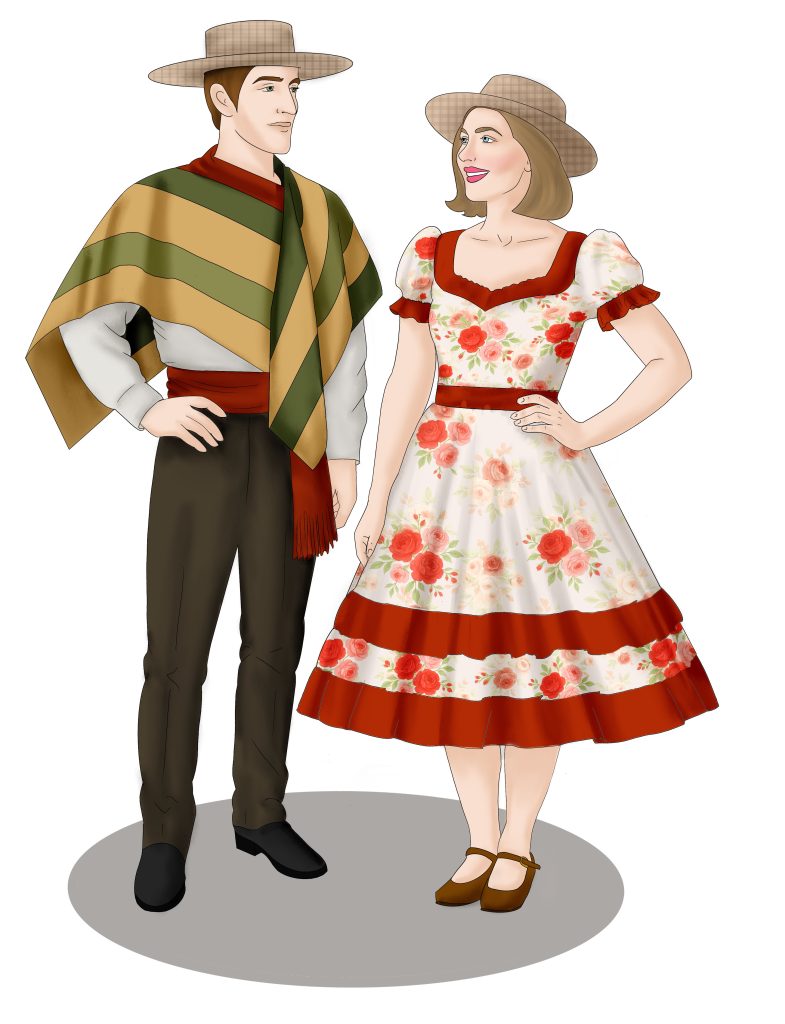
3.2. Traditional Music
Music in the Andean region has a distinctive sound because of its use of woodwinds. The quena is an end-blown flute, typically made from bamboo or wood, with six finger holes and a thumbhole. The zampoña, (panpipes) also called siku or antara, consists of a row of end-blowen hollow tubes of varying lengths, typically made from bamboo or reeds. The tubes are bound together to form a single instrument.
The charango is a small stringed guitar with five pairs of strings. It typically has a rounded body made from an armadillo shell or wood and a short neck.


Other instruments used in Andean music include the six-stringed guitarra, the arpa (harp) and the cajón, bombo and caja drums.
The music in southern countries is actually quite similar to that in other Latin American countries. There is extensive use of guitars, violins, harps, accordions, clarinets, and brass.
- Peruvian Music: https://youtu.be/M_gSydN_BYM?si=4HSTe8fS9N3mEiqb
- Peruvian Music: https://youtu.be/e5WKgLTUNPg?si=pXFfj5lloR1Wjm2B
- Bolivian Music: https://youtu.be/l7U_tnxdPq8?si=2gDKgLsLa17v0Uog
- Ecuadoran Music: https://youtu.be/GOgiKxq7w7Y?si=oMiR__vH3bo7UBMh
- Chilean Music: https://youtu.be/6TvCfFvPdWs?si=E2HNwXaZ96qstb2s
- Argentinian Tango: https://youtu.be/wQf-yx4QB8s?si=YSj3kckYQSKzGnB-
3.3. Tango
Tango is a passionate and melancholic music and dance genre that originated in the late 19th century in the port neighborhoods of Buenos Aires, Argentina, and Montevideo, Uruguay. It is characterized by its emotive melodies, intricate rhythms, and intimate partner dance.
Tango music often features complex harmonies, expressive melodies, and dramatic lyrics that reflect themes of love, longing, and nostalgia. The music is typically played on the violin, piano, bandoneón (accordion/concertina) and guitar. Tango emerged in the late 19th century as a fusion of various musical and cultural influences brought by European immigrants, primarily from Italy, Spain, and Africa, who settled in Buenos Aires. These immigrants brought with them their musical traditions, dance styles, and instruments, which mingled with the rhythms and melodies of the local criollo (creole) population, as well as African musical elements from slaves brought to Argentina.
Tango dance initially developed in the marginalized neighborhoods of Buenos Aires, including La Boca and San Telmo, among the urban poor, immigrants, and Afro-Argentine communities. It was associated with brothels, bars, and dance halls frequented by sailors, dockworkers, and laborers. It was popular in the LGBTQ+ communities. Tango evolved as an improvisational social dance, characterized by close embrace, intricate footwork, and dramatic body movements. It was initially considered scandalous and was often performed in secret in the dimly lit corners of dance halls. Tango experienced a golden age of popularity and artistic creativity in the 1930s to 1950s, becoming a symbol of Argentine identity and culture. One of the most prominent musicians, however, was Uruguayan: El Varón de Tango, Jolio Sosa. Tango gained popularity beyond Argentina, spreading to Europe, North America, and other parts of the world, particularly during the mid-20th century. It became a symbol of exoticism and sophistication, inspiring dance crazes and Hollywood films. In the 1960s and 1970s, tango experienced a decline in popularity in Argentina due to political unrest, economic crises, and changing cultural trends. However, it underwent a revival in the 1980s, with renewed interest in traditional tango music and dance. Today, tango continues to thrive as a living art form, with traditional tango music and dance preserved and celebrated in milongas (tango dance events) and cultural festivals in Argentina and around the world. Contemporary tango also incorporates new styles and innovations, blending traditional elements with modern influences.
Tango is traditionally danced in a close embrace, with one partner taking on the role of the leader and the other partner as the follower. The leader is responsible for guiding the dance, initiating movements, and interpreting the music, while the follower follows the leader’s lead, responding to cues and movements with grace and precision. Tango’s dance roles are often based on traditional gender norms, with men expected to lead and women expected to follow. Traditional tango embraces and celebrates stereotypical notions of masculinity and femininity, with the dance movements and postures often reinforcing gendered expectations. As mentioned above, in the early 20th century, tango was often associated with marginalized groups, including immigrants, the urban poor, and sex workers. As a result, it was stigmatized by mainstream society, and those involved in tango, including LGBTQ+ individuals, faced discrimination and social ostracism. While traditional gender roles continue to shape tango, there has been a growing awareness and acceptance of alternative dance roles and expressions. Many contemporary tango dancers and choreographers challenge traditional gender norms, experimenting with role reversal, same-sex partnerships, and fluidity in movement and expression.
- Traditional Tango: https://youtu.be/DDjp7I77gAI?si=AP9YjtlMTgxVoliG
- Traditional Tango: https://youtu.be/EZz-OCiMzfs?si=fJil0pzAr-8tKten
- Traditional Tango: https://youtu.be/To0swZn-uCU?si=whO656XagctLkq_M
- Ballroom Tango: https://youtu.be/y7ZeTl6bjfU?si=3y0Jg0ouiAevPZBl
- Same-gendered Tango: https://youtu.be/T8ZFH2UPmx8?si=PqJ0zWMynRWZv5iJ
3.4. Indigenized dances
The various indigenous peoples of South America from the Amazon to the Andes and from the Caribbean coast to the southern cone of course have extensive dance traditions of their own. These are often tightly tied to religious rituals as well as social gatherings. Examples include the Machitún dance of the Mapuche, the ritualized combat dance Tinku of the Quechua, the Nandereko of the Guarani people, The Kullawada of the Aymara, the Hãkoma of the Yanomami and many others. These rich dance forms deserve entire books on their own.
As in Central America, there are many places in South America where the national culture is an intricate blend of indigenous, European and African cultures bringing together dance styles from all these cultures. One particularly striking example is the Marinera which is considered Peru’s national dance and is characterized by its elegant and graceful movements, intricate footwork, and colorful costumes. The dance is a fusion of styles of traditional indigenous dances, Afro-Peruvian creole zamacueca, and European dance styles like the Fandango. The dance is done in couples, but the dancers never touch. Instead, they flirt with each other from a respectable distance turning solo in place and circling around each other. The dancers both hold a handkerchief in their right hand. Women hold their skirts out to the sides. Men can hold a straw hat in their left hands. Traditionally the dancers are barefoot.
Diablada, or “Dance of the Devils,” is a ceremonial dance with roots in both indigenous Andean and Spanish colonial traditions. It features elaborate costumes, masks, and dramatic choreography depicting a battle between good and evil spirits. Diablada is accompanied by traditional Andean music, including brass bands, drums, and flutes. Dancers wear ornate and colorful costumes, including elaborate masks representing mythical creatures, angels, demons, and otherworldly beings. The dance is similar to many of the dance dramas found in Central America with themes of the triumph of good over evil.
- Marinera: https://youtu.be/DnLzbLmK6MU?si=qgrtViH-36T6e1Wf
- Marinera: https://youtu.be/_OHb4jy2a0o?si=WPkFX2oYQrQSxrkh
- Marinera: https://youtu.be/xsy4rrZ8d6U?si=E1q0_UrS1MQZAvZx
- Diablada: https://youtu.be/KkXs0xs-67g?si=suY7-yqIfmjBiWnU
- Diablada: https://youtu.be/w-iqN-XRpq0?si=0RiSeVBOwuW27mcV
3.5. Other styles of South American Dance
As would be expected, every region on the continent has their own specialized style of dances, and there isn’t room here to talk about all of them, but here are a few more.
Cumbia is a popular music and dance genre that originated in Colombia and has spread throughout South and Central America. Cumbia music typically features a steady 2/4 or 4/4 rhythm, with prominent percussion instruments such as the tambora, guacharaca, and bass drum. It blends indigenous, African, and European musical influences, with regional variations found in different parts of Colombia and beyond. It was traditionally done solo but is now often done in couples or small groups moving forward in lines around the dance hall.
Zamba is a traditional folk music and dance genre that originated in Argentina, particularly in the northwestern provinces of Salta and Tucumán. It is characterized by its slow tempo, melodic guitar accompaniment, and graceful dance movements. Zamba music often features sentimental lyrics, lush harmonies, and lilting melodies that evoke the natural beauty of the Argentine countryside. It is associated with the cowboy (gaucho culture).
Festejo is a lively and energetic Afro-Peruvian dance characterized by its syncopated rhythm, percussive footwork, and call-and-response singing. It is often performed at social gatherings, parties, and cultural events. Dancers wear traditional Afro-Peruvian attire, including colorful skirts or pants, shirts, and headscarves, often adorned with vibrant patterns or embroidery.
Throughout the continent there is a long tradition of horsemanship, rodeos, and cowboys. These go by a number of names including Huasosin Chile and Gauchos in other parts of the southern cone. The male dancers from these traditions are easily identifiable by their ponchos or mantas, loose pants round flat hats, boots and spurs. The spurs are often used to create a percussive accompaniment to the dance in with stomping and heel clicking sequences.
- Staged Colombian Cumbia: https://youtu.be/QcLSK9mv_mA?si=my51Pwe8fKk8dQXD
- Colombian Cumbia: https://youtu.be/VU5HF-P-LnM?si=EpAuYOaNdkJZsbzn
- Festejo: https://youtu.be/VLqgo1fYZHo?si=csmvdtjmVfXofRQ6
- Festejo: https://youtu.be/PBgPCcJwOJ0?si=1xGkef9Va7Dr3HV7
- Zamba: https://youtu.be/JjVfD-HKFmA?si=lKQyNJsrftzmmLKV
- Chilean Dance, Huasos: https://youtu.be/AjJu9Q4yVJ8?si=mHHeMC8oni04FnJT
- Argentinian Gaucho Dancing: https://youtu.be/xyhPKQlTT4k?si=-KDebxEOlCwKyF9V
- A stage performance of various kinds of Argentine folk dance: https://youtu.be/QoM2bkf2Q1M?si=SfI15sNuIsnAAjzX
- A survey of Argentinian Folk Dances: https://youtu.be/52sbj-pYcPE?si=ay8A7bAj_AEwPj1_
3.6. Zumba
Zumba is a recently created popular fitness program that combines dance and aerobic exercises with Latin music rhythms. Its history traces back to the 1990s and is closely linked to the Colombian dancer and choreographer Alberto “Beto” Pérez. The story goes that in the mid-1990s, Pérez, then a fitness instructor in Colombia, forgot his usual workout music for a class he was teaching. He improvised by using cassette tapes of salsa and merengue music he had in his car, and he choreographed a workout on the spot. This impromptu fusion of dance and fitness became the basis for what would later become Zumba. Recognizing the potential of this energetic and engaging workout, Pérez further developed the concept and created structured routines that incorporated a variety of dance styles and fitness exercises.
In 2001, Pérez moved to Miami, Florida, where he introduced his Zumba workout to the United States. He began teaching classes in local gyms and fitness centers, attracting a diverse group of participants drawn to the fun and dynamic nature of the workout. Zumba quickly gained popularity in Miami and began to spread to other cities across the United States. Its appeal was due in part to its accessibility and inclusivity, as participants of all ages, fitness levels, and dance backgrounds could enjoy the workout.
With its growing success, Zumba evolved into a branded fitness program, complete with licensed instructors, choreographed routines, and branded merchandise. The Zumba Fitness company was officially founded in 2001 by Pérez, along with Alberto Perlman and Alberto Aghion. Throughout the 2000s, Zumba continued to expand its reach globally, with licensed instructors teaching classes in countries around the world. The program’s popularity was fueled by its dynamic workouts, infectious music, and enthusiastic community of participants. Zumba continues to draw inspiration from a wide range of dance styles and music genres, incorporating elements of salsa, merengue, cumbia, reggaeton, hip-hop, and more into its workouts. This diversity reflects the program’s roots in Latin American dance and its global appeal.
- Zumba: https://youtu.be/8HpG0l9cLos?si=2YMH5ltbQSTCJprl
- Zumba: https://youtu.be/_NtsvxutjLk?si=YyBwjuB2cRyERq-R
- Zumba: https://youtu.be/HyHCjpddbzs?si=eYxToKG4oQsPKKRu
Further Reading
- Bottomer (1996), Cavalier (1966), Savigliano (1995). For complete citations see the references section at the end of the book.
Some Suggested Dances For Teaching
- Marinera (Peru): https://folkdancemusings.blogspot.com/2024/07/la-mellizera-marinera-nortena-peru.html
- Arequipa Pukllay (Peru): https://folkdancemusings.blogspot.com/2021/11/arequipa-pukllay-peru.html
- Carnavalito (Bolivia): http://folkdancemusings.blogspot.com/2014/01/carnavalito-bolivia.html
- Chilili (Bolivia): http://folkdancemusings.blogspot.com/2009/10/chilili-bolivia.html
- Cumbia (Colombia): https://folkdancemusings.blogspot.com/2023/09/cumbia-colombia.html
- Samba (Brazil): https://folkdancemusings.blogspot.com/2023/03/samba-kotansky-solo-arrangement-brazil.html
Media Attributions
- Figure 7.1: Map South America © Mapchart.net is licensed under a CC BY-NC-SA (Attribution NonCommercial ShareAlike) license
- Figure 7.2: Gaucho Costumes © Asma, used with permission
- Figure 7.3: Baiana Costume © Asma, used with permission
- Figure 7.4: Cavaquinho © Lionel Scheepmans is licensed under a CC BY-SA (Attribution ShareAlike) license
- Figure 7.5: Cuica © Art Torrance, personal collection. Used with permission
- Figure 7.6: Brazilian Djembe © Art Torrance, personal collection. Used with permission
- Figure 7.7: Berimbau © Art Torrance, personal collection. Used with permission
- Figure 7.8: Pandiero is licensed under a CC BY-SA (Attribution ShareAlike) license
- Figure 7.9: Atabaque © Akuma Rasta is licensed under a CC BY-SA (Attribution ShareAlike) license
- Figure 7.10: Agogô © Freddythehat is licensed under a Public Domain license
- Figure 7.11: Bolivian Pollera © Asma, used with permission
- Figure 7.12: Traditional Chilean Costumes © Asma. Used with permission
- Figure 7.13: Siku, Aymara, Peru © Musical Instrument Museum, Phoenix. Used with permission
- Figure 7:14: Charango © Villanueva is licensed under a Public Domain license

